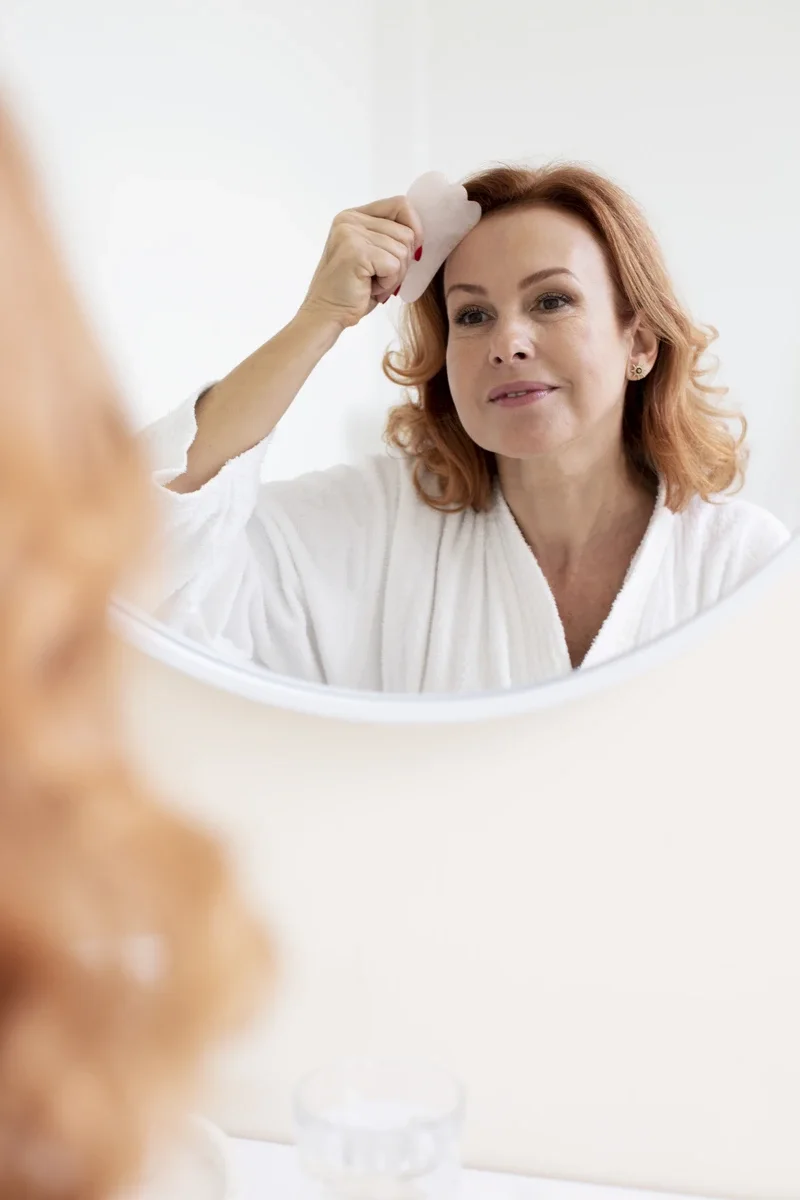While many women view signs of aging, particularly in the skin, as flaws, aging is a natural process that symbolizes experience and growth. That said, the appearance of fine lines, spots, and dryness are entirely normal and can be managed as part of a healthy lifestyle. This guide will explore the symptoms, causes, and treatments for skin aging, especially during menopause, offering practical ways to care for and celebrate skin at every stage.
Causes of Skin Aging During Menopause
Although skin issues and aging may seem like just an aesthetic concern, the skin is actually the largest organ of the human body and supports several key health functions:(1)(2)
Protection: The skin serves as the first barrier against toxins, dehydration, ultraviolet (UV) light, and physical damage.
Sensation: It holds nerves that detect pain, temperature, touch, and pressure.
Immunity: It helps defend the body against pathogens.
Secretion: It releases sweat, oils (sebum), and pheromones and removes excess substances like water, urea, and ammonia.
Temperature Regulation: Healthy skin helps regulate body heat, conserving or releasing warmth to maintain balance — which is particularly important during menopause.
Vitamin D Production: The skin helps start the process of vitamin D synthesis, which is essential for calcium absorption and bone health.
Two main types of factors influence skin aging: intrinsic and extrinsic. Both play a role in how the skin changes over time, particularly during menopause.
Intrinsic (Internal) Aging
Intrinsic aging is driven by factors such as genetics and hormonal changes. During menopause, the decrease in estrogen, progesterone, and testosterone accelerates certain skin changes, such as dryness, thinning, and loss of elasticity. While naturally dry or less oily skin tends to wrinkle earlier, thicker skin may be more resilient but show larger pores. Additionally, skin with less melanin (pigment) tends to be more susceptible to UV damage, leading to premature wrinkles and uneven tone.(3)(4)
Extrinsic (External) Aging
Extrinsic aging refers to external environmental factors that contribute to skin damage over time. These can include the following:(2)(3)(4)(6)
Sun Exposure: UV exposure is the number one cause of skin aging and damages the skin, collagen, and elastin, leading to wrinkles, spots, and rough texture.
Diet: High-sugar diets can accelerate skin aging by contributing to inflammation and weakening the skin structure.
Stress: Elevated cortisol levels inhibit collagen production, making the skin more prone to wrinkles.
Smoking: Smoking deprives the skin of oxygen, accelerates wrinkles, and reduces its ability to heal.
Pollution: Environmental toxins can cause oxidative stress, damaging skin cells.

Common Symptoms of Skin Aging
As time passes, certain visible changes occur in the skin, signaling the aging process. These changes may vary from person to person, but common symptoms include the following:(2)(5)(6)
Fine Lines and Wrinkles: These can appear due to UV damage and loss of collagen.
Dryness and Roughness: This is often linked to reduced estrogen levels and extrinsic environmental factors.
Uneven Skin Tone: This can be caused by excessive sun exposure.
Dullness: This often results from decreased cell turnover.
Larger Pores: As hormones change and collagen declines, pores may become more prominent.
Laxity (Sagging): Loss of collagen contributes to a decrease in skin elasticity.
Dark Spots: UV exposure can lead to the formation of hyperpigmentation.
While these changes can be disheartening, they are a natural part of the aging process. Taking proactive steps to care for the skin can help maintain health and improve overall skin texture and tone.
Preventing Skin Aging
Preventing skin aging starts well before menopause, and the sooner a person adopts good skincare habits, the better the skin will age — but it's never too late. While aging and skin damage can’t be completely reversed, certain treatments and lifestyle adjustments can improve skin health and appearance by reducing visible signs of aging and damage. The following are a few effective approaches:
Sun Protection
Sun exposure is the primary cause of premature skin aging. It’s crucial to use a broad-spectrum sunscreen with at least SPF 30 every day, even on cloudy days. Mineral sunscreen ingredients, like micronized zinc oxide, currently have a safer profile than chemical sunscreens. Wearing protective clothing, wide-brimmed hats, and sunglasses with UV protection can further shield the skin from damage. Avoiding the sun during peak UV hours (10 a.m. to 4 p.m.) and reapplying sunscreen every two hours when outside are also essential steps.(2)(5)(6)
Hormonal Support
Menopause often triggers changes in the skin due to a decline in estrogen, a hormone vital for skin health. Estrogen regulates collagen and elastin production, maintaining the skin’s firmness and elasticity. It also supports hydration, barrier function, wound healing, and pigment balance. As hormone levels decrease with age, supporting hormone balance can help slow skin aging.
Hormone replacement therapy (HRT), in the form of capsules or patches systemically replenishes estrogen levels, addressing whole-body symptoms — including those affecting the skin — by working from the inside out. In contrast, topical skim cream containing estriol acts locally on the skin, directly targeting the effects of estrogen loss in the treated area from the outside in. Research indicates that both methods have the ability to preserve skin elasticity, reduce the appearance of wrinkles, and improve skin thickness and hydration.(3)(9)(11)
Diet and Lifestyle
Eating an anti-inflammatory diet rich in antioxidants — found in fruits, vegetables, and healthy fats — can support skin health from the inside. Omega-3s, for instance, help keep the skin supple, while antioxidants like beta-carotene and lycopene can offer some protective and rejuvenating benefits. Proper hydration is also key to maintaining plump, healthy skin. Additionally, managing stress through meditation, yoga, or daily walks helps keep cortisol levels in check, which is beneficial for the skin.(3)(4)(5)(7)(10)
Best Facial Treatments for Aging Skin
It's important to emphasize that these are elective treatments or procedures. Personal feelings about appearance can vary, and many people feel content with their looks without additional interventions. However, if there is interest in or experience with cosmetic enhancements, it's helpful to have information.
Cosmetic procedures designed to rejuvenate appearance fall into the following two categories:
Non-Invasive (or Minimally Invasive)
These procedures do not involve scalpels or stitches, but they can still carry risks such as pain, swelling, and infection. Ideally performed in a clinical setting, they generally require minimal to no recovery time. Botox, fillers, and chemical peels are among the most popular options, with approximately 25 million procedures performed annually.(8)(12)
Invasive
Invasive procedures involve surgery, which can introduce risks such as infection, bleeding, blood clots, and scarring, along with a long recovery period. Facelifts are a common example. In the United States, about 1.6 million invasive cosmetic surgeries are performed annually.(12)
The following are a variety of non-invasive and minimally invasive treatments available to help improve the appearance of aging skin.
1. Quality Moisturizer (Not Expensive Moisturizer)
A quality moisturizer should contain hydrating ingredients like hyaluronic acid, ceramides, squalane, and peptides, which help lock in moisture and support the skin’s barrier. It’s important to select a formula that matches skin type: a lightweight version for oily skin, a richer texture for dry skin, and fragrance-free options for sensitive skin. Unnecessary irritants like added fragrance or alcohol should be avoided. For best results, it’s a good idea to opt for non-comedogenic products and those with dark or opaque packaging that preserves the product’s active ingredients.(4)(18)
2. Retinoids and Retinol
These are derivatives of vitamin A, known for their powerful effects on cell turnover. They help fade dark spots, smooth fine lines, and improve skin texture, making skin appear smoother and more radiant. Prescription retinoids are stronger than over-the-counter retinols, but they can be more irritating, so it’s best to consult a dermatologist and start slow.(3)(5)(9)
3. Antioxidants (Vitamin C and E)
Antioxidants protect skin cells from damage caused by UV exposure and pollution, which can accelerate aging. Vitamin C, for example, helps brighten skin, fade hyperpigmentation, and boost collagen production. Regular use of a good antioxidant serum may reduce damage and create a smoother, more even-toned complexion.(3)(7)(9)
4. Fillers
For more pronounced lines, injectable fillers are an option. Fillers, such as hyaluronic acid gel, are injected into areas of the face to restore volume and smooth wrinkles. Results are immediate and can last anywhere from several months to a few years, depending on the type of filler used and how quickly the body metabolizes.(13)
5. Neuromodulators
Neuromodulators, such as Botox and Dysport, temporarily relax the muscles responsible for wrinkles. They’re especially effective in treating frown lines between the eyebrows and crow’s feet around the eyes. Results typically appear within a few days and can last for 3 to 4 months. These treatments use botulinum toxin, a neurotoxic protein clinically derived from the bacteria that cause botulism, which works by safely blocking nerve signals to targeted muscles. Originally developed for treating chronic pain and muscle disorders, neuromodulators received FDA approval in the 1980s.(12)(13)
6. Dermabrasion and Microdermabrasion
Dermabrasion involves removing the outermost layer of skin using a rotating tool, encouraging the growth of new, smoother skin. Microdermabrasion is a less invasive version, using tiny crystals to exfoliate the skin. Both treatments can help reduce the appearance of wrinkles, sun damage, and age spots.(8)
7. Microneedling
This involves tiny needles creating micro-injuries in the skin, which boosts collagen and elastin production. It can help improve skin texture, reduce fine lines, and minimize acne scars. Professional treatments offer more impressive results and are safer than at-home devices.(14)
8. Chemical Peels
Chemical peels involve applying an acid solution to remove the outer layer of skin, revealing fresh, smooth skin underneath. This treatment can improve the appearance of fine lines, uneven tone, and dark spots. Recovery time varies depending on the strength of the peel.(8)
9. Fractional Laser Skin Resurfacing
Laser treatments are used to target deeper layers of the skin, stimulating collagen production and improving the texture of the skin. Fractional laser treatments can effectively treat wrinkles, scars, and sun damage, but they do require some recovery time.(15)(16)(17)
10. Non-Ablative Skin Rejuvenation
This non-invasive treatment uses laser or energy-based devices to stimulate collagen without removing the outer layer of skin. It’s a good option for those who want to improve their skin's appearance with a short downtime.(15)(16)(17)
While these procedures can help improve skin's appearance, people should exercise caution. Everyone has a different threshold for risk, so it’s crucial to weigh the potential complications and benefits. Consulting with a certified medical professional before proceeding is highly recommended.
Healthy Skin for Women in Their 30s and Beyond
Skin aging is a natural process to be embraced and celebrated. By understanding its causes and taking proactive steps to care for the skin, it’s possible to age gracefully and maintain a healthy, radiant appearance. From everyday habits like sun protection and balanced hormones to advanced treatments like fillers or lasers, there are numerous ways to support the skin at every stage of life. Aging skin is a badge of honor that many aren’t fortunate enough to earn. Embracing the lines, spots, and changes means celebrating the privilege of growing older and the strength it represents.
Experiencing menopausal skin issues? Discover if HRT is the right choice.
If you’ve entered the menopause transition and are struggling with signs of aging skin, there are options to address these concerns. Systemic hormone therapy and topical treatments can help skin elasticity, hydration, and tone. Take our brief menopause quiz to see if you’re an eligible candidate for HRT. Get started with Winona to take the first step toward feeling and looking your best.
